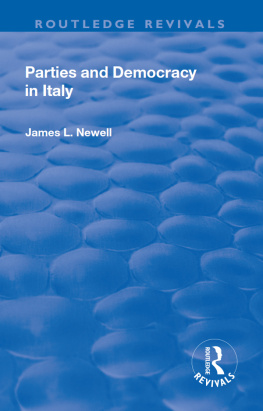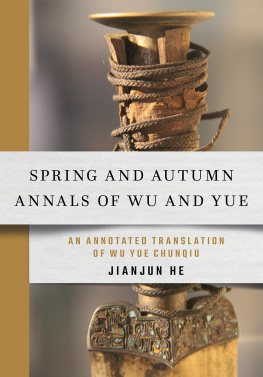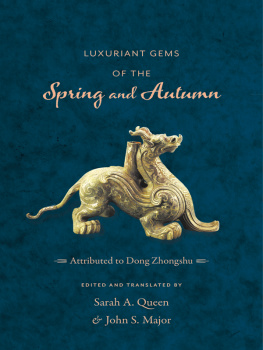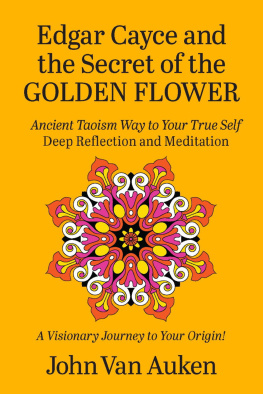Newell Ann Van Auken - The Commentarial Transformation of the Spring and Autumn
Here you can read online Newell Ann Van Auken - The Commentarial Transformation of the Spring and Autumn full text of the book (entire story) in english for free. Download pdf and epub, get meaning, cover and reviews about this ebook. City: New York, year: 2016, publisher: State University of New York Press, genre: Religion. Description of the work, (preface) as well as reviews are available. Best literature library LitArk.com created for fans of good reading and offers a wide selection of genres:
Romance novel
Science fiction
Adventure
Detective
Science
History
Home and family
Prose
Art
Politics
Computer
Non-fiction
Religion
Business
Children
Humor
Choose a favorite category and find really read worthwhile books. Enjoy immersion in the world of imagination, feel the emotions of the characters or learn something new for yourself, make an fascinating discovery.
- Book:The Commentarial Transformation of the Spring and Autumn
- Author:
- Publisher:State University of New York Press
- Genre:
- Year:2016
- City:New York
- Rating:5 / 5
- Favourites:Add to favourites
- Your mark:
- 100
- 1
- 2
- 3
- 4
- 5
The Commentarial Transformation of the Spring and Autumn: summary, description and annotation
We offer to read an annotation, description, summary or preface (depends on what the author of the book "The Commentarial Transformation of the Spring and Autumn" wrote himself). If you haven't found the necessary information about the book — write in the comments, we will try to find it.
The Commentarial Transformation of the Spring and Autumn — read online for free the complete book (whole text) full work
Below is the text of the book, divided by pages. System saving the place of the last page read, allows you to conveniently read the book "The Commentarial Transformation of the Spring and Autumn" online for free, without having to search again every time where you left off. Put a bookmark, and you can go to the page where you finished reading at any time.
Font size:
Interval:
Bookmark:


The Commentarial Transformation
of the Spring and Autumn
SUNY series in Chinese Philosophy and Culture
Roger T. Ames, editor
The Commentarial Transformation
of the Spring and Autumn
Newell Ann Van Auken

Published by State University of New York Press, Albany
2016 State University of New York
All rights reserved
Printed in the United States of America
No part of this book may be used or reproduced in any manner whatsoever without written permission. No part of this book may be stored in a retrieval system or transmitted in any form or by any means including electronic, electrostatic, magnetic tape, mechanical, photocopying, recording, or otherwise without the prior permission in writing of the publisher.
For information, contact State University of New York Press, Albany, NY
www.sunypress.edu
Production, Jenn Bennett
Marketing, Fran Keneston
Library of Congress Cataloging-in-Publication Data
Names: Van Auken, Newell Ann.
Title: The commentarial transformation of the Spring and Autumn / Newell Ann Van Auken.
Description: Albany : State University of New York Press, 2016. | Series: SUNY series in Chinese philosophy and culture | Includes bibliographical references.
Identifiers: LCCN 2016007691 (print) | LCCN 2016009380 (ebook) | ISBN 9781438462998 (hardcover : alk. paper) | ISBN 9781438463018 (e-book)
Subjects: LCSH: Zuoqiu, Ming. Zuo zhuan. | Confucius. Chun qiu.
Classification: LCC PL2470.Z7 V36 2016 (print) | LCC PL2470.Z7 (ebook) | DDC 895.18/107dc23
LC record available at http://lccn.loc.gov/2016007691
10 9 8 7 6 5 4 3 2 1
To my teachers
Contents
Chapter 1
Orthodoxy and Transformation: Two Categories of Commentary
Chapter 2
The Ritual Filter and the Centrality of L
Chapter 3
Hierarchy, Criticism, and Commendation: Recognizing Merit and Assigning Fault
Chapter 4
Two Ways of Teaching the Spring and Autumn : The Sources of the Direct Commentaries
Chapter 5
Other Approaches to Commentary in the Zu Tradition : The Gentleman and Confucius
Chapter 6
Incomplete Correspondences and the Likelihood of Mediated Contact: The Relation of the Direct Commentaries to Gngyng and Gling
Chapter 7
From Recording Rules to Written Text: Conceptual Antecedents to Gngyng and Gling in the Direct Commentaries
Epilogue
From Zhu Gng to Confucius: Textual Creation Myths Forgotten and Replaced
Appendix
Summaries and Topical Lists of the Direct Commentary Passages
Acknowledgments
Many people have provided me assistance, support, and encouragement in writing this book, but I must begin by expressing my debt of gratitude to an anonymous reader. This project was originally conceived of as a much shorter journal article based on a chapter of my dissertation, with the simple aim of presenting a set of commentarial passages concerning the Spring and Autumn that are embedded in the Zu Tradition and showing that they lay out a unified reading of the Spring and Autumn , and are not (as had been commonly supposed) relatively late interpretations. I duly submitted my article for review and subsequently received a particularly inspiring reader report asking questions that I had not considered. As I sought answers, it became clear to me that I had more to say than could be addressed in an article. The anonymous reader asked about the distribution of the commentarial passages throughout the Zu Tradition ; the surprising discoveries I made in the process of answering this question threw light on the sources of these passages and inspired me to think more broadly about the nature of early texts about texts. My answer became , which highlights two fundamentally different approaches to understanding and interpreting the Spring and Autumn , and to early Chinese historiography more generally. Other parts of the report, too, went beyond evaluating and correcting, and gave me mentoring, guidance, and teaching. I may never learn this readers name, but I remain most grateful.
The groundwork for this project was laid during two research visits to the Institute of History and Philology at Academia Sinica in Nan-kang, Taiwan. There, the faculty and staff provided much assistance, and discussions with my sponsor, Chen Chao-jung , , were presented at the Early China Seminar at Columbia University in November 2012, hosted by Li Feng and David Pankenier, and I would like to thank my hosts and the seminar participants for their inspiring and insightful discussion of my work. I have presented various parts of this project in preliminary form at annual meetings of the Western Branch of the American Oriental Society, and I am grateful to my colleagues for their thoughtful questions and comments.
As I neared the finish line, John Major carefully read and gave detailed comments on the entire manuscript and provided warm encouragement at a time when I needed it most. Martin Kern helpfully commented on a much earlier portion of this work and inspired me to learn more about the relation between commentary and teaching. I also thank Sarah Queen, Wai-yee Li, and Joachim Gentz for reading and commenting on parts of this project at different stages of completion. Lisa Indraccolo and Xiubo Shan carefully reviewed portions of the manuscript and saved me from many embarrassing errors.
Many friends were very supportive, but I am particularly grateful to Melissa Curley, Shuang Chen, W. South Coblin, Jennifer Feeley, Laura Nffer, and Richard VanNess Simmons. I also owe a great intellectual debt to my teacher, graduate adviser, and friend, William G. Boltz, who provided me the skills and training to conduct this research.
The late Nancy Ellegate, senior acquisitions editor at State University of New York Press, deserves special mention. Nancy was not only professional and highly competent, but she also gave wonderful support to first-time authors such as myself. She was clear and direct, positive and encouraging, and full of wit and good humor. Sadly, she passed before the completion of this project. I also express my thanks to Jenn Bennett, Jessica Kirschner, and the editorial staff at SUNY Press for continued support, even as they were grieving their loss.
Finally, I thank my beloved husband Van and our two children, Clara and Oliver, whose unfailing love, support, and faith in me have enabled me to bring this project to fruition.
Scholarly Conventions
Chinese characters and romanization are provided at the first occurrence of personal and place names and of titles of works in Chinese. After the first occurrence, Chinese works are referred to by translated title in the chapters and appendix but by romanized title in the notes and bibliography.
The Spring and Autumn ( Chnqi ) text used is that associated with the Zu Tradition ( Zu zhun ), unless otherwise noted. The Gngyng and Gling versions of the Spring and Autumn sometimes differ slightly, and this is noted as appropriate. References to Spring and Autumn records are marked CQ and are keyed to Yng Bjns edition, Chnqi Zu zhun zh . Individual records are designated by ruler, year, and entry number according to Yng Bjns numbering scheme and include corresponding page references. Thus CQ , Yn 3.2, 24 refers to the second record (by Yng Bjns count) of the third year of Lord Yn, on of Chnqi Zu zhun zh . References to the Zu Tradition are marked Zu , and they also refer to Chnqi Zu zhun zh and use similar conventions.
Font size:
Interval:
Bookmark:
Similar books «The Commentarial Transformation of the Spring and Autumn»
Look at similar books to The Commentarial Transformation of the Spring and Autumn. We have selected literature similar in name and meaning in the hope of providing readers with more options to find new, interesting, not yet read works.
Discussion, reviews of the book The Commentarial Transformation of the Spring and Autumn and just readers' own opinions. Leave your comments, write what you think about the work, its meaning or the main characters. Specify what exactly you liked and what you didn't like, and why you think so.








